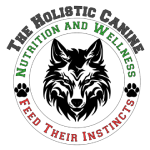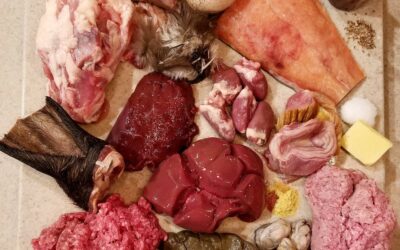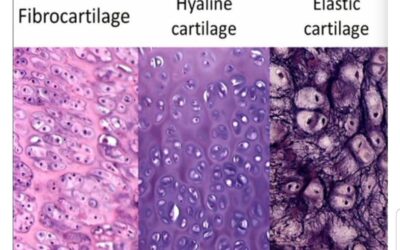©2019 Updated Version
Offering your dog the best possible nutrition plan does not have to be complicated. Not only that, but it does not have to cost you a fortune nor take up hours of your time providing daily meals. Your number one goal should be to supply your dog with everything he needs to cultivate and maintain optimal health along with preventing internal imbalance. Now this may seem like a lofty goal, but I want to assure you, it is not difficult once you learn the basics of meal preparation.
On that note, I want to briefly address the popular “complete and balanced” concept invented by the dog food industry. While the idea of mastering a “complete and balanced” nutrition plan may be on your radar as the ultimate goal, please understand that this is a misguided endeavor. Not only is “complete and balanced” unfeasible, impractical, and based on a cleverly crafted marketing scheme, but the science does not exist to show what this actually looks like. The reason for this is because every biological being has its own unique needs. While domestic canines do have specific energy and nutrient requirements, exactly how much of each nutrient is not exactly clear. Couple this with the fact that energy and nutrient needs change (sometimes daily) based on external and internal conditions, and we are left with a science that is uncertain and theoretical.
What we do have is observational science. What this teaches us is that each species on this planet has its own unique nutritional requirements and therefore consumes very specific food in order to receive from that specific food vital energy and nutritional components. Physiologically, the bodies of each and every species is uniquely designed (or evolved, whichever you prefer) to breakdown (digest) only specific foods from which they are perfectly able to release and utilize the nutritional components from within that food source. These foods are what are known as species-appropriate. For our canines to thrive, we do know which foods they specifically require to promote and cultivate optimal health and optimal health maintenance.
Your dog is anatomically and physiologically a carnivore that, due to the thousands of years of living with and beside humans, has adapted the ability to consume, passably digest, and partially utilize nutrients from carbohydrate-dense foods making your dog a facultative carnivore. However, more than a century of commercial dog food consumption has clearly shown us the worrisome statistics and results from feeding dogs a starch-based diet. While a dog may be able to survive on this type of diet, their quality of life is greatly diminished and the cultivation of optimal health is difficult, complicated, and in many dogs, impossible. Thus, what you feed your dog is critical. Fresh raw species-appropriate food allows your dog to properly unlock and easily absorb vital nutrients in an unhindered manner.
To cultivate optimal health your dog needs whole and/or partial prey or a combination of muscle meats, organs, bones, connective tissues, vessels, skin, and fur/feathers to thrive. Of those two options, providing the latter is far more feasible for the majority of pet parents.
Dogs have no need or use for carbohydrates such as starches, sugars, or fiber. Despite this, there is growing evidence that suggests there may be some benefit to offering your dog small amounts of vegetables and fruit provided it is fed in the correct form. Vegetables require steaming, boiling, and pureeing or juicing. Otherwise, there will be little to no benefit. In fact, most of the most healthful vegetables contain oxalates, phytates, lectins, solanine, chaconine, and goitrogens, for example, all of which can be dangerous to your dog and inhibit overall nutrient absorption from his meals. Cooking helps to remove some of these anti-nutrients making it safer and more beneficial. Keep in mind that vegetables are only optional and are unnecessary in the diet. Fruit, on the other hand, can be offered whole or pureed in small amounts between meals as treats.
Are you ready to begin providing your dog with the most beneficial nutrition plan?
Welcome to The Holistic Canine’s Raw Feeding Guide! The guide uses a ratio guideline as your starting point. The ratio is a rough representation of the approximate meat, organ, and bone composition of whole prey. Creating meals or a day’s worth of meals with the following ratio guideline is simple. You may even choose to provide these percentages over a week’s time. However, despite many veterinarians and canine nutrition professionals recommending balance over a week’s time, I do not recommend that. Balance over a few days is fine, but a week is not my preferred method. For my own six dogs, I provide the balance daily.
When creating meals with the ratio as your guide, you want your main focus to be on providing all of the nutrients that your dog requires to be optimally healthy. If you are unsure of your dog’s NRC, FEDIAF, or AAFCO nutrient recommendations, go to my article here to discover what your dog requires or contact me for assistance. Once you have those in hand, you are ready to create species-appropriate meals!
If you would like a FREE pdf copy of the guide, go to the contact page and request your free copy.
80% MEAT
65% muscle, 15% organ muscle
| Beef Chicken Turkey Goat Lamb Mutton Pork Rabbit Duck Quail Salmon, Mackerel Sardines, Anchovies Oysters, Mussels Whiting, trout | Venison Bison Elk Llama Emu Heart Gizzards Green Tripe Cheek Tongue Lung Trachea* Eggs (chicken, duck, quail) Off cuts, Briskets, Fillets, Grinds |
*thyroid hormone contamination and exposure is possible
| Meat Provides: | ||
| Protein (amino acids) Fats (essential fatty acids) Zinc Phosphorous Potassium Copper | Nitrogen Iron Magnesium Selenium Chromium Carnosine (antioxidant) | Carbon B vitamins Vitamin D Vitamin K Folate Creatine |
10% – 15% BONE
12% – 15% puppies
| Chicken thighs Chicken drums Chicken necks Chicken wings Chicken feet Chicken backs Chicken carcass Turkey necks Turkey backs Turkey wings Goat ribs Goat necks Lamb/sheep ribs Lamb/sheep neck Ox tail Beef neck | Duck heads Duck feet Duck necks Duck wings Duck backs Cornish hen frames Quail frames Poultry carcass Rabbit ribs Rabbit thigh Rabbit heads Rabbit feet Pork neck Pork tail Pork ribs Pig feet |
| Bone Provides: | |
| Calcium Magnesium Chloride Potassium | Phosphorous Sodium Sulfur Silica |
| Marrow Provides: | |
| Fatty Acids Iron Zinc Selenium Manganese | Vitamin A Vitamin K Vitamin E Boron |
| Connective Tissues Provide: |
| Glucosamine Chondroitin |
10% ORGAN
5% liver, 5% other secreting
| Beef/calf liver Beef kidney Beef spleen Beef pancreas Bull testicles* Chicken liver Turkey liver Duck liver Brain Eyes | Pork liver Pork kidney Pork spleen Pork pancreas Pork thymus (sweetbreads) Goat/sheep liver Goat/sheep kidney Goat/sheep spleen Goat/sheep testicles* Ovaries* |
*hormone exposure is likely, feed with caution or do not feed to intact dogs
| Organs Provide: | ||
| Protein (amino acids) Fats (fatty acids) Iron Selenium Phosphorous Manganese Chromium | Nitrogen Copper Zinc Potassium Magnesium Sodium Co-Enzyme Q10 | Carbon Vitamin A B vitamins Vitamin D Vitamin K Vitamin C |
FRUIT & VEGETABLES
May feed 5% up to 10% (NON-essentials)
| Raspberries Blueberries Blackberries Cranberries Watermelon Apples Pears Rosemary Basil Parsley* Thyme | Zucchini Lettuces Cucumber Wheatgrass Spinach* Broccoli*† Cauliflower † Pumpkin Asparagus Barley grass Avocado |
*Contains oxalates. Oxalates bind with iron and calcium and contribute to kidney stones
† Inhibits synthesis of thyroid hormones, feed in MODERATION
NOTE: I do NOT recommend feeding fruits with meals. In the presence of protein and fat, fruit ferments in the stomach and gut contributing to stomach upset, intestinal irritation, loose stools, and an increased risk for Bloat (a deadly condition).
| Fruits & Vegetables Provide: |
| ALL vitamins ALL minerals Phytonutrients Antioxidants Fiber |
OTHER FOODS TO SUPPLEMENT
Beneficial Non-essentials
| Goat’s milk Kefir Cottage cheese Raw milk Hemp seeds (raw, ground) Pumpkin seeds (raw, ground) Chia seeds (ground, gelled) Kelp Spirulina, Chlorella Marine phytoplankton Alfalfa powder Golden paste | Coconut oil MCT oil Hemp seed oil Flaxseed oil Krill oil Bone broth Fish stock Medicinal mushrooms Apple cider vinegar Coconut water Green lipped mussel powder Diatomaceous earth (food grade) |
My recommendation is to add these supplemental foods, powders, and oils AS NEEDED for their nutrient profiles, to balance fats in a meal, for extra calories, for their medicinal properties and constituents, and for a functional purpose such as digestive aid, worm prevention, natural therapies, and chronic disease and cancer preventative and therapy.
Do NOT Feed
- Grapes
- Raisins
- Onions, all (garlic is still under debate)
- Green tomatoes
- Artificial sweeteners (ALL!!)
- Xylitol
- Alcohol
- Cacao (cocoa & chocolate)
- Walnuts & macadamia nuts
- Whole grains (corn included)
- Legumes (soy included)
- Rawhide
- Processed snack foods
- Sugars & candy
- Yeast, dough
- Corn on the cob
- Bell pepper seeds
- Hot peppers
- Blue cheese
- Gum
- Mouthwash, toothpaste
- Cooked fat
- Cooked bones
- Hops
- Tomato and avocado leaves
- Cat food
- Peanut butter spreads*
*Peanut butter spreads are not peanut butter. Peanut butter is peanuts only (salt may be added). Peanut butter spreads contain thinning oils and often sweeteners. Xylitol is a zero calorie sweetener commonly added to spreads. This is DEADLY.
HOW TO CREATE A MEAL
You will want to feed 2% to 4% of your dog’s ideal body weight. Puppies require 4% of their projected adult weight or 7% to 10% of current weight until 3% of their projected adult weight is reached.
Whole prey is balanced perfectly without the need for plants. If you cannot feed whole prey, use a ratio as a guide:
80/10/10
This means = 80% meat, 10% bone, 10% organs.
My preferred ratio is a breakdown of 80/10/10. It looks like this:
65/15/10/5/5
This means =
- 65% muscle meat + 15% organ muscle (80%)
- 10% bone (MINIMUM)
- 5% liver + 5% other secreting organ (10%)
Feeding with raw meaty bones (RMB):
- 65/15 meat = 40% to 60% meaty bone(s) + 5% to 25% boneless meat + 15% organ muscle meats
- 10 organ = 5% liver + 5% other secreting organ(s)
Ideally, your meals will consist of approximately:
- 40%-60% RMB
- 5%-25% boneless meats
- 15% organ muscle
- 5% liver
- 5% other secreting organ(s)
- You may wish to try creating a semi-whole animal using various animal parts if you cannot feed whole prey. We call this Frankenprey. This also helps to feed ratios most similar to whole prey.
- Feed three meals per day for puppies under 12 weeks old.
- Feed two meals per day for puppies older than 12 weeks.
- I recommend feeding adults one meal per day to benefit from fasting. Some people and dogs prefer or need two meals per day. Feed according to your dog’s needs or your schedule/convenience.
You will want to discover your dog’s nutrient requirements for his/her age and weight. You can use the nutrient requirements recommended by the NRC, FEDIAF, AAFCO, or The Holistic Canine. You will find nutrient requirements for dogs and puppies here. The nutrient charts are based on 1,000 kcal. If you need assistance learning your dog’s specific requirements, contact me for assistance.
Remember the ratio is ONLY A GUIDE. There is no rule that dictates that the ratio needs to be followed exactly. The main goal is to provide the highest balanced nutrient saturation in each meal or meals per day without creating or causing an imbalance within your dog. An imbalance can be caused by the creation of a dangerous nutrient antagonism or synergism in meals, not feeding enough ingredient variety in a consistent rotation, feeding species-inappropriate foods, adding/feeding too many plant ingredients (especially with anti-nutrients), meals consistently lacking in necessary nutrients, meals consistently excessive in a particular nutrient or nutrients, or veering too far off the ratio guideline. Some dogs require higher bone percentages.
Bones can be fed up to 25% of the diet. Do not exceed 25%.
Please note: feeding raw does not necessarily increase the life expectancy of every dog. What it does do is greatly reduce the risk and rate of chronic disease as well as improves quality of life. Many dogs do in fact live very long lives on raw diets, others do not. However, had those shorter lived dogs not been raw fed, their lives would likely have been even shorter. Understand that by feeding a species-appropriate diet you are providing your dog with the best possible nutrition IF and ONLY IF you follow a balanced raw protocol. The Holistic Canine exists to make sure you do just that. We are here to help!
©2019 Kimberly Lloyd, PhD, BCHHP, Cert Raw Dog Food Nutritionist
©2019 Created by The Holistic Canine, Macon, GA





































































